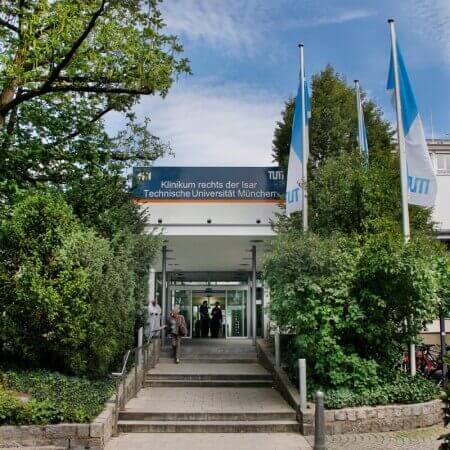Uterine prolapse impairs the quality of sexual life and increases the risk of developing vaginal inflammatory diseases and cancer. However, pelvic organ prolapse can be successfully treated. You can opt to undergo your treatment in Germany. German doctors perform minimally traumatic operations that allow them to securely fix the uterus in the proper anatomical position and avoid its recurrent prolapse in the future. On the Booking Health website, you can find out the cost of treatment and choose a medical care program at the best price for your preferred dates.
Content
- What is uterine prolapse?
- Diagnostics
- Conservative treatment
- Hysterectomy
- Organ-preserving surgery
- Why to undergo your treatment of uterine prolapse in Germany?
What is uterine prolapse?
Uterine prolapse is one of the types of pelvic organ prolapse.
50% of women have some degree of pelvic organ prolapse. The risk of the disease increases with age: after the age of 45, prolapse is detected in 26% of women, and after 50 years, the prevalence of pathology rises to 57%.
The causes of the disease are unknown. Risk factors include childbirth, obesity, and conditions accompanied by chronically elevated intra-abdominal pressure, such as bronchial asthma or constipation. Hereditary predisposition also plays a significant role in the development of the disease.
Prolapse can be classified based on its location as follows:
- anterior;
- median;
- posterior.
In different types of this pathology, various organs may protrude into the vagina, such as the rectum, bladder, uterus, urethra, or part of the peritoneum and small intestine. Uterine prolapse refers to median prolapse.
The disease has the following symptoms:
- sensation of a foreign body in the vagina;
- gaping genital slit;
- severe uterine prolapse causes the formation of ulcers in the vagina;
- pain during sexual intercourse.
Uterine prolapse can often be combined with an anterior or posterior prolapse. In such cases, women complain of frequent urination, urinary incontinence, and difficulty defecation.
Diagnostics
Pelvic organ prolapse can be diagnosed clinically. Medical imaging methods are used to clarify the diagnosis. Doctors usually conduct an ultrasound scan, while an MRI scan or computed tomography are less commonly used.
The choice of treatment tactics for prolapse depend on its severity, which can be assessed according to the POP-Q system:
- grade 0 prolapse is when a woman has a normal position of the pelvic organs;
- grade 1 prolapse is when its lower edge is localized at a level of 1 cm from hymenal remnants;
- grade 2 prolapse is when it occurs less than 1 cm from hymenal remnants in any direction;
- grade 3 prolapse can be diagnosed when its edge is localized 1 cm or more downward from hymenal remnants;
- grade 4 prolapse implies complete or partial vaginal eversion.
Conservative treatment
On the one hand, the development and progression of pelvic organ prolapse and uterine prolapse provokes elevated pressure in the abdominal cavity and, on the other, weakness of the pelvic floor muscles and connective tissue (uterine ligaments). Accordingly, to slow down the development of prolapse and reduce symptoms, measures must be taken to:
- lower intra-abdominal pressure;
- strengthen the pelvic floor muscles;
- support the organs of the reproductive system, thereby reducing the load on the uterine ligaments.
Unlike ligaments, which can only be strengthened through surgery, muscles can be strengthened through exercise. The first exercises are led by an instructor. After training, however, a woman can do exercises on her own. Workouts should be regular and constant. They not only strengthen the muscles but also improve the blood supply to the pelvic organs and connective tissue structures, thereby increasing their strength.
The following lifestyle modifications are also required to slow down the progression of pelvic organ prolapse:
- smoking cessation;
- increased intake of fiber and water to eliminate constipation;
- body weight adjustment (regular exercises and diet);
- exclusion of heavy physical exertion, which may increase intra-abdominal pressure.
Gynecologic pessaries can be used to support the pelvic organs. They are usually the first treatment option for women with grade 1-2 prolapse. Pessaries are devices made of medical silicone that are placed inside the vagina. They hold the organs in an anatomically proper position. Pessaries eliminate most of the symptoms of prolapse and also slow down the progression of the disease.
A woman needs to undergo regular examinations by a gynecologist and change pessaries every 3-12 months to avoid any complications. At the initial stage, patients sometimes have to change several pessaries to find the right one in which it is comfortable to walk, urinate, bend over, etc. without shifting the device. Approximately 30% of women experience side effects from the use of pessaries, but they are usually mild and do not significantly affect the quality of their lives. Women with atrophic vaginitis also use estrogen creams to reduce the risk of vaginal side effects.
Hysterectomy
A hysterectomy, or uterus removal surgery, helps to permanently resolve the problem of uterine prolapse in older women. The intervention can be performed through different surgical approaches:
- vaginal;
- abdominal (through an incision in the anterior abdominal wall);
- laparoscopic (through short incisions in the anterior abdominal wall).
A vaginal approach is considered the first choice. It allows doctors to eliminate the prolapse of not only the uterus but also other pelvic organs. A pelvic floor reconstruction can be performed at the same time.
Open operations are not common in Germany, as laparoscopic interventions are used instead of them. They are much less traumatic and provide a relatively rapid recovery for patients after surgery.
After removing the uterus, German surgeons perform a stage of surgical intervention that reduces the risk of pelvic organ prolapse recurrence (vaginal vault prolapse). Doctors fix tissues to the uterosacral or sacrospinous ligaments. These are reliable treatment options with a recurrence rate of less than 10-15% at the best medical centers.
Organ-preserving surgery
Removal of the uterus is unacceptable in young and middle-aged women. In such cases, doctors perform operations to preserve the uterus. Dozens of types of interventions are used in gynecology for prolapse treatment. Some of the surgical treatment options are listed below:
- shortening of the round and broad ligaments of the uterus;
- ventro-fixation of the uterus according to Kocher (suturing to the anterior abdominal wall);
- MESH-vaginopexy is a laparoscopic procedure that strengthens the uterosacral ligaments by using a synthetic flap;
- laparoscopic sacrocolpopexy involves the placement of a mesh prosthesis, which is sutured to the transverse presacral ligament, levators, and the posterior wall of the uterus;
- hysteropexy using aponeurotic strips is the strengthening of the ligaments with flaps from the aponeurosis of the abdominal external oblique muscles.
Operations can be performed through a laparotomy or a laparoscopic approach. Some hospitals use robot-assisted surgery instead of conventional laparoscopy, which is considered safer. Manipulations in this type of intervention are performed by the manipulators of a robotic surgical system, which the surgeon controls remotely.
A laparoscopic sacrocolpopexy has become the most widespread among all organ-preserving operations performed for uterine prolapse in Germany. This is a treatment method that involves fixing the uterus to the anterior longitudinal ligament at the sacrum using a synthetic mesh. The operation is an improved and less traumatic type of the classic open sacrocolpopexy, which has been used in gynecology since 1958. A laparoscopic sacrocolpopexy provides reliable results at the best German hospitals, as the risk of recurrence is up to 6% within 8 years.
This operation has the following advantages:
- efficiency at different hospitals ranges from 93 to 100%;
- fixation to the sacrum is made in the natural direction of the vaginal axis;
- weak tissues are strengthened with synthetic materials, which minimizes the risk of prolapse recurrence in the future;
- the normal length of the vagina is maintained, which is important for women who continue their sexual lives.
A colpocleisis is an alternative treatment option for women who do not plan to be sexually active. This is not a reconstructive operation but an obliterative procedure. Doctors suture the vagina. The operation is minimally traumatic, and the risk of complications is close to zero. Prolapse relapses almost never occur. Reliability is the main advantage of this operation. But still, it is not used as often as other types of organ-preserving treatment. Another disadvantage, in addition to the inability to have sex, is the lack of access to medical procedures, for example, doctors cannot conduct a smear test or perform a diagnostic curettage of the uterine cavity.
Why to undergo your treatment of uterine prolapse in Germany?
Many patients prefer to have their treatment at German hospitals. They have state-of-the-art equipment. German hospitals employ doctors who are considered among the best in the world. You can count on the treatment of uterine prolapse in Germany to be minimally traumatic, safe, and reliable.
There are a few reasons for you to undergo your treatment in Germany. These are the following:
- highly accurate diagnostics allow doctors to assess the severity of uterine prolapse and detect concomitant prolapse of other organs to optimally plan treatment;
- modern types of pelvic floor surgery are used instead of outdated operations that cause a high percentage of complications and recurrences;
- at a woman's request, doctors can preserve the uterus by performing reconstructive interventions instead of a hysterectomy;
- the high quality of sexual life can be preserved or restored after the operation, as a woman does not experience any pain and the length of the vagina is not decreased;
- a low risk of recurrence of pelvic organ prolapse that is only about 6% at the best German hospitals;
- treatment in Germany is minimally traumatic, as a hysterectomy is performed through a vaginal or laparoscopic approach, and a sacrocolpopexy is performed through a laparoscopic approach;
- surgeons in Germany perform robotic surgery that is considered the safest in the world;
- patients are guaranteed high-quality care and comprehensive rehabilitation after the completion of their treatment in Germany.
You are welcome to use the Booking Health service to find out the cost of treatment and compare prices at different hospitals. Our specialists will advise you and help you organize your trip. When you make your appointment through Booking Health, the cost of treatment abroad will be lower for you than when contacting a medical center directly. Prices will be reduced due to the lack of additional coefficients for foreign patients. In addition, the initial cost of treatment is final and will not be increased after the start of your medical care program. When you make an appointment for your treatment in Germany through the Booking Health service, you will receive insurance covering medical expenses that are not covered by your medical care program.
Authors:
The article was edited by medical experts, board-certified doctors Dr. Sergey Pashchenko and Dr. Vadim Zhiliuk. For the treatment of the conditions referred to in the article, you must consult a doctor; the information in the article is not intended for self-medication!
Sources:
WHO - World Health Organization
Verywell Health
MedicineNet




















